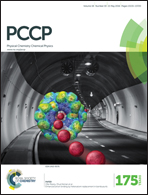An analytical model of hydrogen evolution and oxidation reactions on electrodes partially covered with a catalyst
Abstract
Our previous theoretical study on the performance limits of the platinum (Pt) nanoparticle catalyst for the hydrogen evolution reaction (HER) had shown that the mass transport losses at a partially catalyst-covered planar electrode are independent of the catalyst loading. This suggests that the two-dimensional (2D) numerical model used could be simplified to a one-dimensional (1D) model to provide an easier but equally accurate description of the operation of these HER electrodes. In this article, we derive an analytical 1D model and show that it indeed gives results that are practically identical to the 2D numerical simulations. We discuss the general principles of the model and how it can be used to extend the applicability of existing electrochemical models of planar electrodes to low catalyst loadings suitable for operating photoelectrochemical devices under unconcentrated sunlight. Since the mass transport losses of the HER are often very sensitive to the H2 concentration, we also discuss the limiting current density of the hydrogen oxidation reaction (HOR) and how it is not necessarily independent of the reaction kinetics. The results give insight into the interplay of kinetic and mass-transport limitations at HER/HOR electrodes with implications for the design of kinetic experiments and the optimization of catalyst loadings in the photoelectrochemical cells.



 Please wait while we load your content...
Please wait while we load your content...